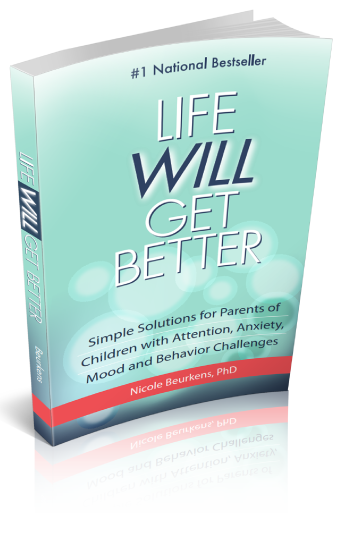With changes in our environment, food and overall stress levels, it’s hard to say just how many kids are suffering from tic disorders.
But research is showing that one in every 360 children are experiencing some sort of vocal or physical tic. If symptoms last over a year, with tics and twitching waxing and waning but never truly leaving, a child can be diagnosed with Tourette Syndrome. Children can also experience tics resulting from exposure to infections (strep is a common one), and tics can be present in kids diagnosed with neurodevelopmental disorders including ADHD and Autism Spectrum Disorders.
More on Tourette Syndrome
While the news focuses on the cursing side of Tourette Syndrome, it’s important to know that many kids have mild to moderate cases. This means that they do not shout out obscenities or have less than stellar lives. The condition is very manageable and has no bearing on a child’s future. However, it can be distressing and frustrating for children and parents alike. Many people are motivated to find solutions to their tics and twitches, especially if they interfere with life activities. In many cases, symptoms tend to improve overtime and many children find their tics to be much less severe or gone entirely by the time they reach adulthood. Still, adults can still have tics or a diagnosis of Tourette’s and experience the same tics that children with T.S. would have. Some prime examples of common tics in children and adults are:
- Blinking
- Head nodding
- Repetitive touching
- Throat clearing
- Shrugging
- Coughing
- Word or phrase repetition
Facial Tics: Types and Disorders
Facial tics are usually less severe than more complex motor tics, although they can be just as distracting. There are a wide variety of different facial tics, including:
- Squinting
- Tongue clicking
- Lip pursing
- Eyebrow raising
- Licking the lips
There are three major disorders that can cause tics: Transient tic disorder, Chronic motor tic disorder, and Tourette Syndrome.
- Transient tic disorder is a temporary issue that can cause regular muscular or vocal tics, although they last for less than a year.
- Chronic motor tic disorder is characterized by persistent tics that occur for at least one year. Kids with the disorder generally do not need treatment, since tics caused by the disorder often subside eventually. Adults with chronic motor tic disorder have many options for treatment!
- Tourette Syndrome typically causes multiple vocal and motor tics, and is usually developed during childhood. Symptoms tend to subside over time, but there are lots of treatment options for kids or adults with severe tics.
Common Tourette Syndrome Treatments
There are multiple treatment options for people with Tourette Syndrome, although there is no definitive cure. The two most common treatments are medication and behavioral therapy. Unfortunately, medication is often used unnecessarily and can cause more problems than it creates. There are no prescription drugs that are approved by the Food and Drug Administration to treat T.S., so a variety of other medications are often prescribed for related issues including ADHD. However, these drugs are often ineffective and bring with them a host of negative side effects that can cause patients to experience a downward spiral after starting on medication. For this reason, natural treatment options and therapy-based practices are much more appealing.
Don’t Panic!
Whether your child suffers from tics, or has a diagnosis of T.S., all is not lost. There’s much you can do to alleviate your child’s symptoms naturally. Here’s how.
Five Ways to Alleviate Your Child’s Tics Naturally
- Magnesium: Kids who tic often have less than optimal magnesium levels. One way to improve magnesium levels is to increase your child’s intake of magnesium-rich foods such as almonds, spinach, or pumpkin seeds. You may also want to consider using a magnesium supplement. I find that magnesium citrate or magnesium glycinate often work best, but avoid the citrate if your child tends to have loose stools. Depending on the size of your child, 250 – 500 milligrams of a quality magnesium supplement can often reduce twitches and vocal tics.
- Epsom Salt Baths: Another way to infuse magnesium into your child’s body is through Epsom salt. Consider adding anywhere from a 1/2 cup to 2 cups of Epsom salt to the nightly bath routine. Kids can also soak their feet in a warm Epsom salt foot bath for twenty minutes. The magnesium will not only be absorbed body directly through the skin, but can also promote soothing and calming. This is an excellent routine to do right before bed, as it can help kids fall asleep a bit more quickly. A good night’s sleep is really important for reducing tics!
- NAC: Standing for N-Acetyl Cysteine, NAC is an amino acid that increases the level of glutathione in the brain. This promotes detoxification, which is necessary for healthy brain and body function. NAC also serves as an antioxidant. Research has shown positive results with children who suffer from OCD and is showing promising results for those compelled to tic and twitch. Studies on NAC for these issues in children typically use anywhere from 600mg of NAC daily to 3,600mg daily (in divided doses) depending on the age, size, and symptoms of the child.
- Identify and Address Food Sensitivities: While your child might not vomit the moment after he eats a bagel, it doesn’t mean his body can handle the gluten or dairy appropriately. A build-up of foods that irritate your child’s immune system can cause inflammation in the brain and body, and this can cause them to tic. Consider working with a healthcare practitioner who can run tests and use other methods of identifying and addressing food allergies, intolerances, or sensitivities. Elimination diets are also very effective at determining which specific foods may be exacerbating symptoms. This involves eliminating one food, or category of foods, at a time to see how it impacts symptoms. Keep a meticulous food log to track response. Also be aware that tics come and go, so it can be difficult to gauge whether taking away dairy really eliminated that shoulder shrug or if it’s just the natural waxing and waning of the tics. Sometimes it requires a few attempts at removing and reintroducing foods to determine what makes a real difference. In my experience gluten, dairy, eggs, corn, and artificial chemicals tend to be the most common offending foods for kids with tics.
- Eliminate Dyes: Speaking of artificial chemicals in food, research shows that artificial food dyes can cause major problems for some kids, including tics. These chemicals over-excite the brain, leading to symptoms of ADHD, anxiety, behavioral disorders, tics, and more. Consider eliminating anything that gets its color from unnatural sources, which means avoiding foods with ingredients like Red #40, Yellow #5, and any other color that is not from a natural source. Here’s a more in-depth post I published about Artificial Food Coloring and Behavior.
Diet is Often a Critical Factor for Kids with Tics.
As you can imagine from a few of the tips above, one of the easiest and often most effective ways to alleviate tics is to keep a close eye on specific problem foods. Here are a few of the most common foods that make tics worse:
- Gluten
- Corn
- Dairy
- Eggs
- Artificial colorings, flavorings and sweeteners
- Highly sweetened or caffeinated beverages (Coffee, energy drinks, soda, and more)
What NOT to Do If Your Child Tics
As hard as this advice is, it’s really important that you don’t spotlight your child’s tics by commenting about or otherwise drawing attention to them. Either they don’t know that they’re doing it (in which case why make it a big deal?), or they are very aware of their movements/sounds and don’t need to be reminded of it. Tics are like itches – the more you think about not scratching, the more you want to do it. The less attention placed on their movements and noises the less stress they will feel. With stress being a big aggravator of tics, it’s best to stay as calm as possible.
The Bottom Line
Watching your child tic can feel overwhelming and frustrating. Remember that you did not cause the condition, and your child is not to blame either. There are many natural strategies you can implement, and even small steps can make a big difference. Start with the strategies above, and don’t hesitate to reach out to a holistic or integrative healthcare provider experienced in addressing tics to access additional support as needed.
What You Should Do Next:
Sign up for my Better Behavior Naturally community newsletter
Sign up for my newsletter to get tips, resources, and supports to improve your child’s attention, anxiety, mood, and behavior…while making your job as a parent easier.
Enroll in one of my workshops
Check out one of my many workshops where you’ll join my exclusive community of parents in a one-of-a-kind virtual resource accessible 24/7. Whether you’ve got a child with a diagnosis like autism or ADHD, or are becoming more and more frustrated with a child who struggles to listen and cope, these workshops are designed to give you the information, tools, and support you need…whenever you need it.








